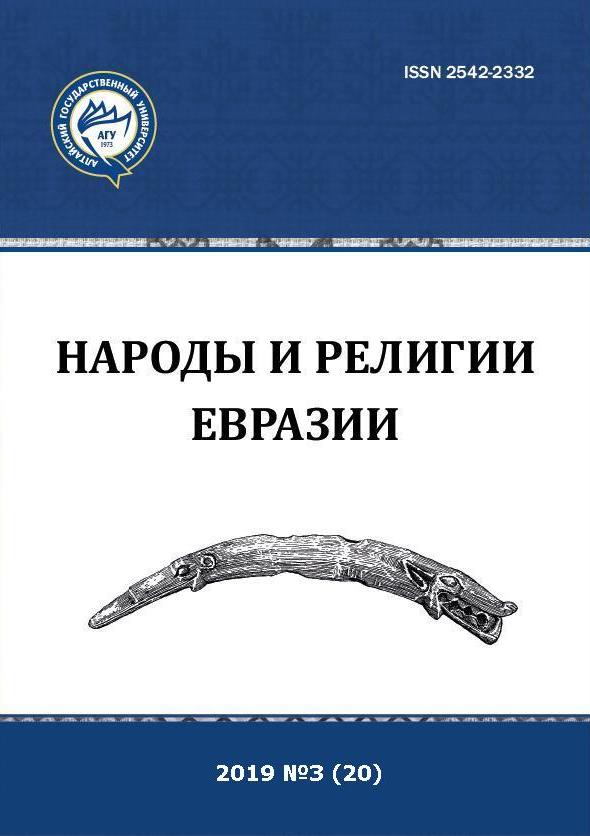The “cities” of nomadic Scythians
Main Article Content
Abstract
The issue of temporary “cities’ of nomadic Scythians consisting of tent wagons and removable yurts which arose at the site of the Scythian families and the locations of Scythian aristocrats, Tzars and Nomarhs, is considered in the article. The transition to a nomadic way of life, which was based on extensive herding, was impossible without a number of technical achievements: the development of a perfect system for reining a horse, the widespread development of iron and, as a consequence, the emergence of high-tech and reliable weapon. The creation of dwelling, the most adapted to the conditions of nomadic life was of great importance. First of all, a tent wagon covered with felt, became such a dwelling, drawn by slow, but powerful oxen. In our opinion, besides the tent wagons, the Scythians already had such characteristic dwellings for nomads in the form of removable yurts installed on a platform base. During the stay, tent wagons and removable yurts of the Scythians, especially when it comes to influential and populous Scythian cities, as well as the nomadic locations of the Scythian leaders, from a distance could seem to the traveler to be a real city.
So-called catacombs are characteristic Scythian burials, especially for IV BC. They consist of a vertical entrance pit (in the mounds of the Scythian aristocracy, its depth could reach 15 m) and one or more burial chambers arranged in the walls or at the corners of the entrance pit. These chambers had an arched vault, resembling a canopy of Scythian tent wagon. Considering that the wheels sometimes appeared on the pledge of these chambers, it can be safely assumed that the Scythian burial chambers recreated the habitual dwelling of the deceased, a tent wagon in which he was born and died. In this case, the “cap” of the Scythian mounds of the hemispherical shape could recreate another nomadic dwelling — a yurt.
Downloads
Metrics
Article Details

This work is licensed under a Creative Commons Attribution 4.0 International License.
References
Бибиков С. Н. Древнейший музыкальный комплекс из костей мамонта. Очерк материальной и духовной культуры палеолитического человека. Киев, 1981. 108 с.
Гей А. Н. О некоторых символических моментах погребальной обрядности степных скотоводов Предкавказья в эпоху бронзы // Реконструкция и интерпретация древних идеологических представлений. М., 1999. С. 78–113.
Гробница Цинь Шихуанди в окрестностях Сияня. URL: http://www.advantour.com/rus/china/xian/qin-shi-huang-tomb.htm.
Дашковский П. К. Лошадь в религиозно-мифологической системе номадов Горного Алтая VI–II вв. до н. э. // Археология и этнография Алтая. Вып. 1. Горно-Алтайск,
2003. С. 16–25.
Дашковский П. К., Карымова С. М. Вещь в традиционной культуре народов Центральной Азии: философско-культурологическое исследование. Барнаул, 2012. 252 с.
Етнічна історія давньої України. Киев, 2000. 276 с.
Латышев В. В. Известия древних писателей о Скифии и Кавказе. Вып. 1–2. СПб., 1992. 151 с.
Латышев В. В. Известия древних писателей о Скифии и Кавказе. Вып. 3–4. СПб., 1993. 289 с.
Лукиан. Скиф или гость. URL: http://www.othist.ru/istochniki_ant_029.html.
Масанов Н. Э. Кочевая цивилизация казахов: основы жизнедеятельности номадних обществ. Алматы ; Москва, 1995. 320 с.
Мурзин В. Ю. О каменных «крепидах» скифских курганов // Старожитності Степового Причорномор’я і Криму. Т. ХІХ. 2016. С. 94–112.
Ніколова А. В. Абсолютна хронологія ямної культури Північного Надчорномор’я в світлі дендродат // Археологія. 2012. № 4. С. 14–31.
Новоженов В. А. Чудо коммуникации и древнейший колесный транспорт Евразии. М., 2012. 499 с.
Плетнева Светлана. Половцы. М., 2010. 211 с.
Путешествие в восточные страны Плано Карпини и Рубрука. М., 1957. 272 с. + карта.
Пушкин А. С. Собрание сочинений: в 10 т. М., 1960. Т. 3. 542 с.
Страбон. География: в 17 кн. / перевод, статья и комментарии Г. А. Стратановского. М., 1964. 957 с.
Тишкин А. А., Дашковский П. К. Социальная структура и система мировоззрений населения Алтая скифской эпохи. Барнаул, 2003. 430 с.
Хрестоматія з Історії України. Киiв, 1996. 332 с.
Яворницький Д. І. Історія запорізьких козаків. Львів, 1990. Т. 1. 319 с.

